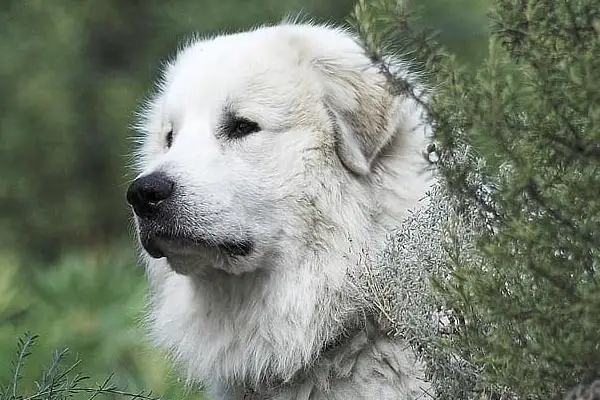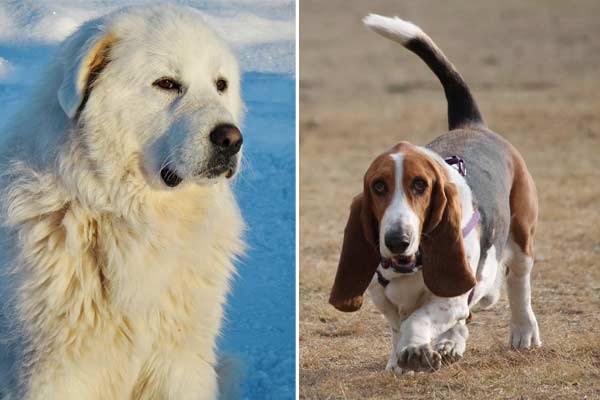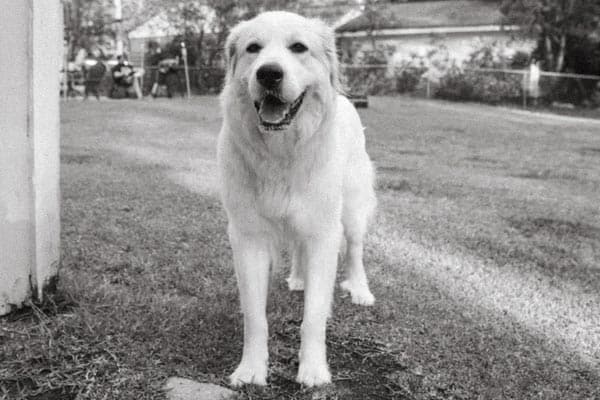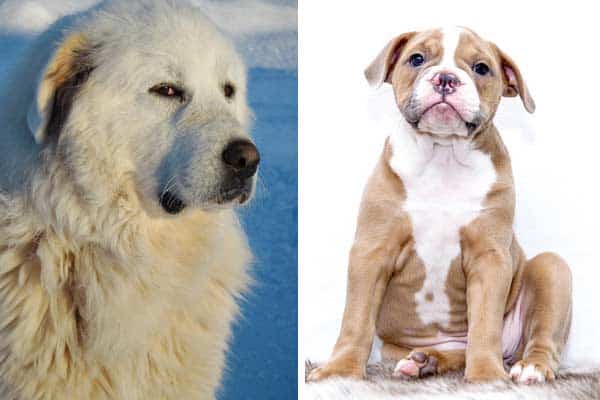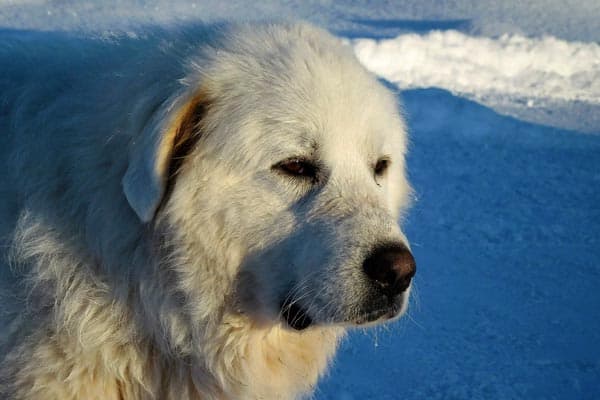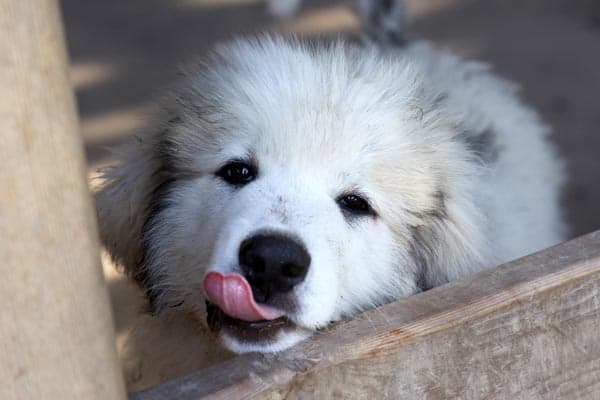Black Great Pyrenees: Can They Exist?
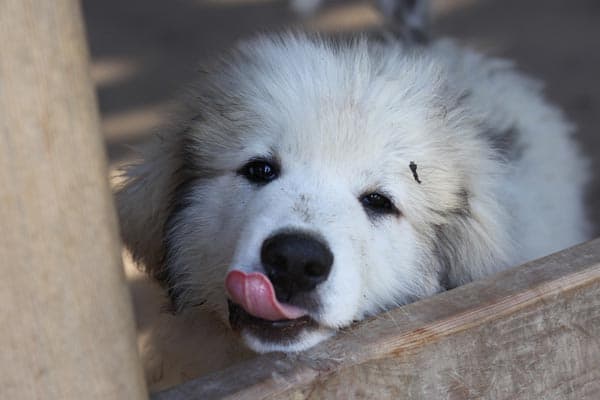
Have you ever heard of a black Great Pyrenees? If you ever saw one, you would surely dismiss it as a Newfoundland. Other possibilities that would run through your mind would be a credible mix such as the Border Collie.
If someone tried to sell you a black Great Pyrenees, how would you react? Would you walk away, or would your curiosity get the better of you? You might demand official registration papers or a DNA test.
The black Great Pyrenees is elusive because major registries do not accept it. Moreover, many experts do not believe it exists in the breed’s gene pool.
However, there are numerous claims of black puppies showing up rarely in litters from two white Great Pyrenees parents.
Four theories to explain black Great Pyrenees are an excessive black gene, mixed heritage, a throwback from ancient French lines, or a spontaneous mutation.
We explore how a black Pyrenees may exist, discussing each of the four theories. First, we discuss the breed standard and the acceptable colors.
What color should Great Pyrenees be, according to major registries?
Major registries throughout the world designate a standard for purebred dogs. This breed standard was in some cases originally based on the dog’s intended purpose. As dog shows became more important, a greater emphasis was placed on appearance.
Nevertheless, major registries still attempt to adhere to what they deem is possible in a breed’s genetic makeup. For example, Weimaraners are blue or Isabella.
You are not suddenly going to get a black and white spotted Weimaraner unless there is an extreme mutation. The AKC recognizes that such a pattern does not exist in the Weimaraner gene pool.
That example is extreme, but it is the same reason why black Rottweilers and merle French Bulldogs are not recognized. Many experts feel certain colors must have come from outside some of the breeds in which they appear.
The Great Pyrenees, also known as the Pyrenean Mountain Dog, comes in limited acceptable colors.
- Solid white
- White with gray, tan, or reddish markings – Markings must be limited to ears, the base of the tail, and very few patches on the body
- White with badger markings limited like other colors – Colors other than white cannot account for more than a third of the dog’s coat
What color is a badger?
Badger is a type of agouti coloration whereby the hair shaft has multiple color bands. In other breeds, you might see people use the term sable. With badger, specifically, the tips are dark while the base is a much lighter brown.
People often mistake badger markings for black on a Great Pyrenees but looking more closely clears up any confusion very quickly.
This video shows a classically marked white with badger Great Pyrenees puppy. Just as mentioned, the badger looks black, especially towards the edges of the ears.
However, you notice immediately all the brown surrounding it. Moreover, if you were to run your fingers through this puppy’s fur opposite the hair’s growth, you would see it is brown or tan at the base.
Theory 1: Excessive Black Gene in Great Pyrenees
When breeders refer to an excessive black gene, it is unclear what they mean. A good place to start is to ask why Great Pyrenean Mountain dogs are white in the first place.
They may have Anatolian Shepherd and Maremma Sheepdog in their ancestry, but what genetically is responsible for the white coat?
It turns out that the Great Pyrenees is similar to the White German Shepherd. Think about all the dogs you know that have black facial masks.
The gene responsible for that is MCR1 or the extension gene. That same gene also dictates the ability of a dog to express black pigmentation, or eumelanin, in its coat.
Each copy of a gene gets a letter to designate it. The extension gene is “E.” Of course, each trait requires two gene copies.
Dominant genes mask recessive genes and get a capital letter. Recessive genes are not capitalized and must have both copies, or they will not be visible.
Thinking back to dominant and recessive genes, “E/e” and “E/E” will both be able to produce a dark-colored coat while “e/e” can only express yellows and reds without black.
It is often called the red/yellow recessive gene. Such dogs are not able to have a black mask either. You could write a dog with a facial mask as “Em/Em,” “Em/E,” or “Em/e.” You might be able to deduct that a dark facial mask is a dominant gene.
Other genes besides those at the “E” locus play a part in the Great Pyrenees coat. The Great Pyrenees is “e/e,” and cannot express black.
All yellows, reds, and creams receive influence from a phaeomelanin modifier which serves to dilute these pigments.
Therefore, the yellows and reds the Great Pyrenees would ordinarily show become diluted to white.
These dogs, like the Samoyed and closely related Kuvasz, are called “false” whites because their true color is clear sable (“ay”) or wild sable (“aw”). The phenomenon is breed-dependent.
Similar modifiers work on the coat of a yellow Labrador or golden retriever, with dogs ranging from deep golden or yellow to cream or near white.
Dogs with genes for deep pigmentation, which is the case in many breeds, will be yellow, golden, or solid red. In other dogs, modifiers do not cover the entire coat.
This means reds or yellows can “creep” through in certain areas such as the ears, face, and isolated spots on the body.
Maremmas can have a tint through their entire coat like the GSD. The Great Pyrenees shows focal or localized areas of red or tan.
Badger is a tan- or red-based agouti color and thus will appear in designated spots like other Pyrenees markings.
So, what would it take from a genetic standpoint to get a black Great Pyrenees? One of two things would need to happen.
In the first scenario, the individual in question would carry a latent dominant black gene which is at a different locus, “K.” Moreover, the dog would also somehow have a dominant “E” gene, which would be impossible given that both parents are white.
The “E” locus overrides “K” which determines if a dog will be black, brindle, or express an agouti pattern. Since “e/e” dogs cannot express black, they cannot be brindle or dominant black. Those “K” expressions become mute.
The second scenario is a recessive black gene, which you can also see in black German Shepherds.
Recessive black is on an agouti gene like a fawn and wolf gray. However, its existence in the Great Pyrenees gene pool is questionable at best. Moreover, it would still require the ability to show black in the coat or a dominant gene at “E.”
German Shepherds are commonly tan-pointed with black masks. Dominant extension genes are prominent in their DNA. The great Pyrenees are all white, making the existence of a dominant extension gene improbable.
The excessive black gene some breeders talk about can apply to any color except black. If the Great Pyrenees was solid badger or tan in color, it would be due to a phaeomelanin modifier or lack thereof.
Even this occurs with extreme rareness in the breed. The dog would still be “e/e,” or unable to express black.
Summary of Great Pyrenees Genetics
The Great Pyrenees likely has the following genotype – ee/kyky/ayay/cchcch. Alternatives involve “ce” replacing “cch” and “aw” replacing “ay.”
- “e/e” – Masks the expression of eumelanin; rules out black and its dilutions, liver and blue; also excludes brindle
- “ky/ky” – Can express agouti designated by “a”
- “ay/ay” – Clear sable or reddish yellow to tan; fawn in some breeds; tan, yellow, or orange markings on Great Pyrenees
- “aw/aw” – Wild sable or grayish; badger in Great Pyrenees
- “cch/cch” – Chinchilla gene, dilutes phaeomelanin
- “ce/ce” – Full dilution of pheomelanin; dog is completely white
Theory 2: Mixed Heritage
Purists tend to firmly adhere to the concept that the Great Pyrenees can’t be black without the influence of other breeds. There are a few breeds they propose as possible candidates.
Border Collie
Although Border Collies can be blue or red merle, blue, black, or brindle, many of them are black and white with Irish white spotting. Some so-called solid black Great Pyrenees have markings similar to Border Collies down to the white-tipped tail.
This litter of Border Collie Great Pyrenees mixes is solely to illustrate the different colors. Note how difficult it is to get a black-marked Great Pyrenees mix, even with this combination.
There is one dog that is almost a solid badger, and the others are white and tan or white with badger patches. These badger markings often fade as puppies grow older.
One pup is white with numerous black markings. It is difficult to tell how large these dogs will be or what they will look like, but this is a common designer dog. Chances are that black Great Pyrenees are not usually Border Collie mixes.
Pyrenean Mastiff
We could not find a good example of a Pyrenean Mastiff and a Great Pyrenees mix. However, this breed began as a Spanish Mastiff x Great Pyrenees mix.
Note how Pyrenean Mastiffs tend to be piebald with definitive colored patches rather than the more subtle local areas of the Pyrenees.
Pyrenean Mastiffs often have black markings, and some speculate black-marked Pyrs are mixed with this dog.
Newfoundland
A ton of Newfoundland Great Pyrenees mixes have speckling like this guy. Different individuals have varying degrees of black.
Many of them also have this quality of coat, although it is difficult to tell whether the owners have possibly shaved them.
However, the large head and broad muzzle suggest mixed ancestry in most of these dogs. Fanciers familiar with Newfoundland claim the Great Pyrenees played a crucial role in the creation of the Landseer, or black and white, Newfoundland.
Theory 3: Throwback Gene from Past Generations
The third theory is an expansion on the second theory. It merely suggests that there is no attempt to mislead anyone, but there must be another breed that got into the mix at some point.
Calling out a dog for mixed ancestry is especially tricky when the owner says he or she ran a DNA test on the dog. But what does a DNA test mean when trying to prove a dog is purebred?
How do canine DNA tests work?
The important thing to keep in mind about a canine DNA test is that it does not prove that a dog is purebred. Astonishingly enough, it also does not prove that a dog is not purebred.
When you send cells from your dog’s cheek to the analysis center, it compares the results to a database.
What comes back is a percentage that tells you how close your dog measures up to different breeds. The more data exists on a particular breed, the more reliable the results.
According to Dnamydog.com, an 87.5% match or higher to a particular breed indicates a purebred dog.
Other tests suggest a purebred dog if the data only finds one breed that is a match. Several factors weigh into this result, however.
- Unreliable sample – Dogs have bacteria in their mouth that destroys a lot of DNA
- Breeds that have a wide range and diverge in different geographic areas – May get a result that says a purebred dog is not pure
- Major registries do not use DNA results to prove a dog is purebred – They use them to prove parentage and are increasingly using them for health screening
- DNA tests typically only go back three generations
How to Use Canine DNA Tests
Canine DNA tests are particularly useful for trying to determine which breeds are in the background of a dog with mixed heritage.
They become less useful if your dog is a Heinz 57 with multiple breeds at several generation levels. In such cases, you may get no match.
As mentioned, DNA tests are indispensable for proving parentage. The AKC or whatever registry you are working with has the final say on which dogs gain entry.
A DNA test can prove that a litter of puppies has a sire and a dam that are already AKC-registered.
There is a presumption that the registered parents are purebred and therefore any related puppies can take their places in the registry and on the family tree.
Colors serve as the last gateway. You cannot register a black Great Pyrenees with the AKC. Show dog people are not going to actively try to produce a bunch of unpapered dogs with a black puppy that appears randomly in one of their litters.
Is there a French connection to the black Great Pyrenees?
Some owners of black Pyrenees explain that the color existed in the ancient French registry. That certainly is possible as the Great Pyrenees more than likely had some influx from the Tibetan Mastiff.
However, as of 1920, French registries strictly prohibited any black in the breed, according to Espinay.com.
This suggests that black had not been a part of the Great Pyrenees’ color repertoire for a long time.
French descriptions went so far as to say that black markings on the Great Pyrenees denoted crossbreeding.
The Great Pyrenees almost went extinct.
St Bernards struggled several times in their history, approaching extinction near 1820 and again in the 1850s.
The Great Pyrenees were used in breeding programs to revive St Bernard beginning in 1870, according to Nationalpurebredogday.com.
Ironically, the Great Pyrenees faced a similar fate after 1909 when mountain predator numbers declined. Shepherds who no longer had use for these great beasts sold them indiscriminately.
Since Pyrs were working dogs, there was not yet a formal breed standard. Unscrupulous breeding practices after the dog lost its purpose led to an overpopulation of inferior specimens.
These dogs not only were useless for guarding but also took on incorrect forms.
It is possible a lot of crossbreeding took place, perhaps introducing black genes. This also explains why France expressed concerns about mixed breeding in their standard.
When Great Pyrenees clubs reformed, they hand-picked suitable dogs to revive the breed based on looks.
Still, you cannot move past the fact that if all these dogs fit the color standard, then they were over 66% white. With the presence of the recessive extension gene in Pyrs, they cannot be carriers of the dominant form of “E” without having black-based coats.
Therefore, having a black dog high up in the family tree with the black gene sitting dormant for a few generations does not seem possible.
Likewise, there is no way to breed two “e/e” dogs and somehow get an “E” that will allow a puppy to have a black coat.
Once you get black markings, however, you can cross that dog with other Great Pyrs and get dogs with white or black coats.
Assuming your dog with markings is “E/e,” her crossing with a white dog would produce “E/e” (black dog) at 50% and “e/e” (white dog) at 50%.
The former would be carriers for the recessive yellow gene, allowing two dogs with black markings to produce white dogs at a rate of 25%.
The other question you may have is how does the white Pyrenees end up with black markings?
The Great Pyrenees is thought to have yet another influencer on coat color, the white spotting gene.
However, the white spotting gene, “Sw,” is masked by the “E” allele. Therefore, when you cross the Great Pyrenees with a dog with dominant “E” genes, you will see white spotting.
- Piebald dog – 33% or more white often with large patches of color
- Irish spotting – Dog with white in a stereotypical and symmetrical pattern (think Boston Terrier markings or Bernese Mountain Dog)
Theory 4: Spontaneous Mutation
Spontaneous mutations can occur in dogs and disrupt normal coat patterns. This is the only theory that would unequivocally explain a black coat in a purebred Great Pyrenees.
Paw Print Genetics, a laboratory tasked with determining the likelihood of certain colors appearing in different breeds, concedes it does not yet have testing to define or detect coat pattern mutations.
We must consider mutations seriously because a few breeders describe black puppies born to white parents.
They have tested these pups with reputable DNA laboratories that have come back listing the Great Pyrenees as the only breed. We discussed earlier how this can happen, but repeated isolated reports seem odd.
So, we are left to discredit anyone who claims to have a purebred black Great Pyrenees or acknowledge that a few isolated cases might be possible. Or we must accept the possibility of another cause of a black hair coat in a predominantly white dog that scientists are not yet aware of.
Most cases that claim a black Pyrenean Mountain Dog describe a white dog with black markings. However, a few demonstrate a mostly black dog with Irish white spotting.
Videos of black Great Pyrenees, like this one, demonstrate correctness in its form characteristic of the Pyrenean Mountain Dog.
Note the distinctive power-driven slightly rolling gait from the rear, the tail carriage, and the luxurious coat.
Does it also fit some of the other large livestock guardian breeds that can be dark in color? That is hard to say for sure.
However, we did not find black livestock guardian dogs that look anything like the Great Pyrenees are.
Moreover, it seems unlikely you could get such a correct head with a mixed breed dog. The only dog that comes close is Newfoundland. The only question remains, “Is this dog badger?”
Regardless of what we might think about black Great Pyrenees we see online, a few white dogs with black markings have appeared so correct that the Continental Kennel Club has allowed them into its registry.
We leave you with this final word on why black Great Pyrenees breeders are credible. If you believe their websites, they breed working dogs. Sources universally remark on their hesitancy to cross LGDs because different breed infusions affect the dog’s interactions with livestock.
Livestock guardian dogs work differently with flocks depending on their breed, and people grow comfortable with particular styles. The dogs’ caretaking is largely instinctual and learned from previous generations.
You can imagine how mixing the Pyrenees with a Newfoundland, Labrador, or Border Collie would affect how it worked. Black Pyrenean owners remark that their dogs have no deficiencies in their working abilities.
